Issue #1: Collaboration in a Time of Coronavirus
Quarantine advice from a 7-year-old, "viral" memes, and a movement exercise!
Welcome!
These Strange Times is a collaborative project between two friends, Dilshanie Perera and Grace H. Zhou, cultural anthropologists and writers based in Oakland, California.
This newsletter is our way of deprogramming: from a decade of graduate school and--let’s face it--from capitalism and its accepted structures of hierarchy, oppression, and exploitation. It is a project to reground, to reengage in the world through collaboration, care, creativity, and community.
In this space, we will be writing about topics like conspiracy theories, internet culture, utopian dreams, toxicities of all kinds, and ghostly histories of colonization. We hope to offer writing that is playful, provocative, and ponderous. We will also feature interviews and occasional guest contributors so please reach out if you have any scintillating tales to share. We hope to create an intimate, virtual community.

Data journalist Mona Chalabi creates illustrations that visualize data in poignant and educational ways. Above she highlights the percentage of the US population that is vulnerable to the spread of COVID-19 and disease in general. Surprise! It turns out to be almost everyone. Source: Instagram @monachalabi
Quarantine Advice from a Seven-Year-Old Under Lockdown
— Grace
What strange times we live in. While folks--including myself--rushed to attend as many dance classes as we could until the escalating shut down brought us to our senses, pandemonium rages alongside pandemic, alongside the very real losses and hardships faced by many communities in the US and around the world. My grandfather was hospitalized in Chengdu with fever and pneumonia that luckily proved not to be COVID-19 as it responded to intensive antibiotics. A cousin of mine is struggling to come to terms with the traumatic loss of her friends in Wuhan, whole families that so tragically succumbed to illness before the medical system could adequately address the crisis.
Here in California, in what now feels like eons before the “shelter in place” announcement, I wrapped up teaching on Zoom. A conclusion marked not by the usual grading of final papers, but trying to figure out how to support and accommodate students facing housing insecurity amid other anxieties and uncertainties. And then there are the heavy burdens faced by more vulnerable communities, the elderly, healthcare providers, those living with chronic illness, and those already struggling with affordability and financial barriers that are being little acknowledged. This shows how much we need Medicare for All. Workers’ benefits. A responsible and compassionate government. Now and always.
And in the midst of all this, there is also the rising energy of community support, mutual aid, collaboration. Alternative modes of being and relating through both art and action. Folks are organizing support networks in the form of grocery deliveries, virtual dinners, relief funds, etc. In some ways, it feels like the only way to get through this is to make ourselves more available, more open--in creative and ingenious ways--despite the fears that make us want to shut down, close up, and seal off. This, perhaps, is the only glint of silver limning a dark, dark stormcloud.
I have been talking to friends and family, near and far, a lot more than usual. My mom and I were on a video call with my 7-year-old cousin, Bubu, who has been under lockdown in China for two months. I asked him if he had any tips for those of us entering similar periods of isolation and quarantine. A few days later, the Bay Area, and then California, announced “shelter in place.” This is an excerpt from our conversation.
* * *
Grace: Nihao Bubu! How are you?
Bubu: [Remains silent with a huge smile on his face.]
Bubu’s dad: He couldn’t sleep last night. He was so excited that he would get to talk to you and his erguma [second aunt] that he didn’t fall asleep until midnight.
G: He was that excited to talk to us?!
B’s dad: He hasn’t talked to anyone in months.
G: Bubu, what do you do all day?
B: I wake up, I have breakfast, I have [Chinese] language class, then I have math class, then English class, then language class again, then PE, then calligraphy…
G: Wow, you sound really busy! Are your classes digital?
B: I have lots of homework and assignments every day! My teacher records the lessons and posts them on QQ [a Chinese social media platform].
[Bubu gets distracted and starts running around the room as a pent up boy is wont to do. He shows us his library and we spend the next half hour flipping through picture books.]
G: Bubu, do you ever feel bored or frustrated staying at home every day?
B: School is cool. Home is stuffy.
G: Do you argue with your parents? With your sister?
B: I fight with my sister everyday! She is so annoying. She says I’m annoying so how can she not be annoying?
G: What are you most excited to do when you’re finally allowed to go outside again?
B: PLAY!!! I want to go to the playground. Let me show you, we have one downstairs. [He walks to the window and shows me the view outside his highrise. A sprawling, empty playground gleams below.]
B’s dad: He’s technically allowed to go there because it’s in our apartment complex, but he’s been too scared since the coronavirus appeared.
B: I’m not scared. [He pauses.] But I haven’t even reached adolescence yet. I don’t want to be made to die.
[He changes the subject] Erguma! I’m the strangest kid! Look, my top teeth haven’t even fallen out yet, but my bottom teeth are loose!
[Bubu’s dad explains that he started losing baby teeth during the lockdown.]
G: Bubu, what advice do you have for those of us who will have to stay home all day? You already have so much experience after two months of lockdown. Pretty soon, I will be in the same position. What are your recommendations?
B: Get up between 8 and 9 in the morning. Eat breakfast, then relax for 30 minutes. Then make your plans for the day. Remember to get some exercise. And practice calligraphy! [He shows off his calligraphy worksheets.]
G: How do you exercise, can you show us?
B: Just get a yoga mat and jump! Jump! Jump! I do different kinds of exercises: jumping jacks, running, jump rope, fuzzy caterpillar, push ups, stretch and relax. [He demos the exercises.] Don’t be like my parents. They just laze around all day!
Without further ado, here are some movement exercises from Bubu. It’s basically HIIT (high intensity interval training) folks, from a 7-year-old. So jump!
* * *
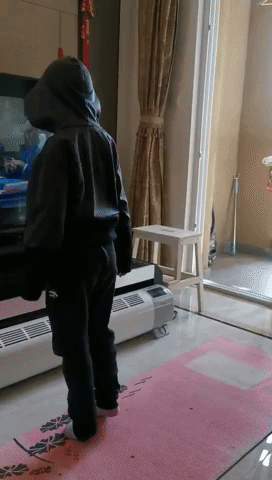
Bubu’s Movement Exercise
Do exercises 1 through 5 for one minute each, rest for one minute between exercises. Repeat the series a few times. At the very end of the workout, stretch and relax.
1. Jumping jacks
2. Fuzzy caterpillar
[Start from a standing forward bend with hands on the ground; crawl your hands forward through the “down dog” position and into a plank; crawl your hands back the way you came; repeat.]
3. Burpees
[You know, that horrendous fitness move combing squats, planks, and jumps all in one.]
4. Jump rope with imaginary rope
5. Push ups
Virality in Another Form
— Dilshanie
Lately I’ve been flitting between tweet threads from healthcare providers, refreshing the Johns Hopkins COVID-19 map, and toggling back and forth between the news, group chats, and the direct messages from friends and family. Connecting with the loved ones has been so important for grounding and good cheer. It’s a source of uplift seeing how people are caring for each other, checking in, setting up networks of mutual aid, deepening already-existing pathways of support, and demanding a fundamental restructuring of how we lived before so that how we live in the future can be less morally depraved and maybe even more just, more humane, and more rooted in solidarity.
I have a folder of memes and pithy tweets concerning the pandemic that friends have sent me and that I’ve been collecting from different parts of the internet. Memes have been such a boon in staving off some of the more recent dread. I’m sharing a few below with extremely light analysis and/or running commentary. Enjoy!
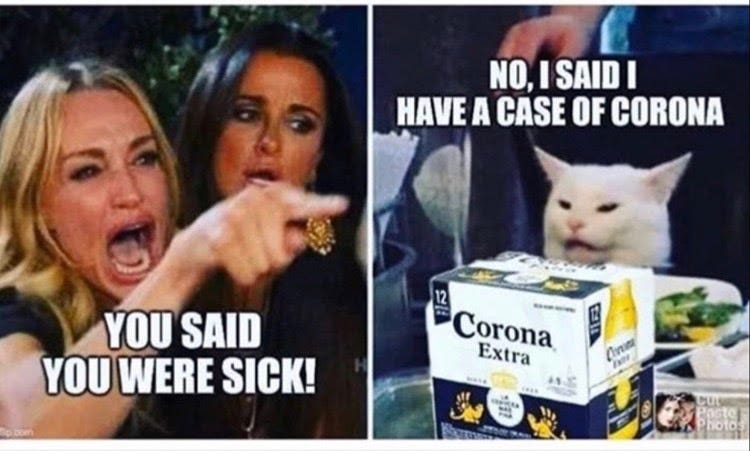
Above we see a Real Housewives x Salad Cat meme (via @aminatou). The form has become a classic. A dramatic still from the TV show pairs perfectly with an image of a cat seated at a dinner table. The shouted accusation that’s met by a calm contrary response is endlessly iterable, which is true of many meme formats. Different text can be dropped into the same (or slightly altered) image for hilarious effect, like the digital union of MadLibs and a New Yorker cartoon caption contest dragged into the 21st century. A meme’s iterability contributes to its circulation, cultural shelf-life, and potential to go viral.
Cute and Sad: Tiny Little Animals
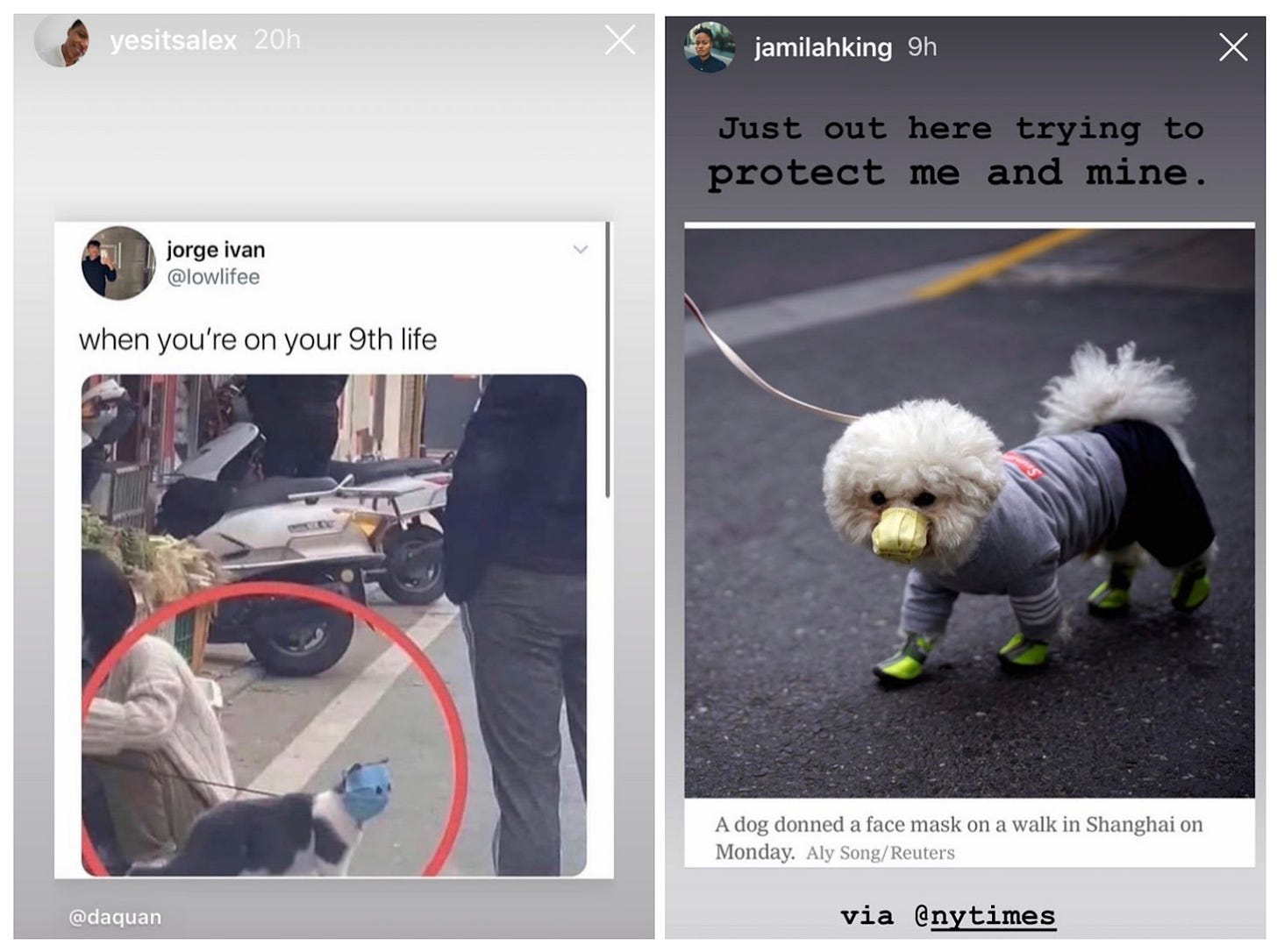
Seeing these cats and dog wearing protective masks makes me grind my teeth together because of their overwhelming cuteness, a phenomenon that has been called “cute aggression.” Cultural theorist Sianne Ngai deconstructs cuteness as an aesthetic category. Ngai writes that “cuteness names an aesthetic encounter with an exaggerated difference in power” (2005: 828). For her, cuteness is an aesthetic relation that connotes vulnerability, softness, diminution, smallness, and helplessness. The subject or object apprehended as cute is fundamentally disempowered. Any injuries or accessories that highlight the vulnerability of the subject (i.e. a dog or cat wearing a mask!) exacerbate that power differential. Ngai says that this showcases a sadistic aspect in what is otherwise a cuddly feeling! I’d suggest that these cute pets wearing masks become subjects onto which one can not only displace fears but also highlight a moral obligation for the care of others. Also, please note that the lil pup is wearing what looks to be a Supreme sweatshirt! This wee doggo, then, can be part of any hype bestiary!

Three of the cat and dog posts above also emphasize the potential viral circulation of images, memes, and tweets. We encounter a viral image at some point past its origination. A TikTok video can travel faster than a pandemic, though both highlight our global interconnectedness. Artist Alexandra Bell (@yesitsalex) and writer and editor Jamilah King (@jamilahking) cite the nested sources they are drawing on to do the public service of bringing these mask-wearing pets to our social media feeds. A man named Liam Hackett, by contrast, simply acknowledges that he slightly altered a joke he saw on Facebook and is now basking in the digital accolades of 1.1 million likes and a tweet gone viral. Virality rewards, but like most phenomena or institutions claiming to be meritocratic, all the sociological categories of privilege influence who is celebrated, who gets credited, and who benefits from viral media.
On Colonialism
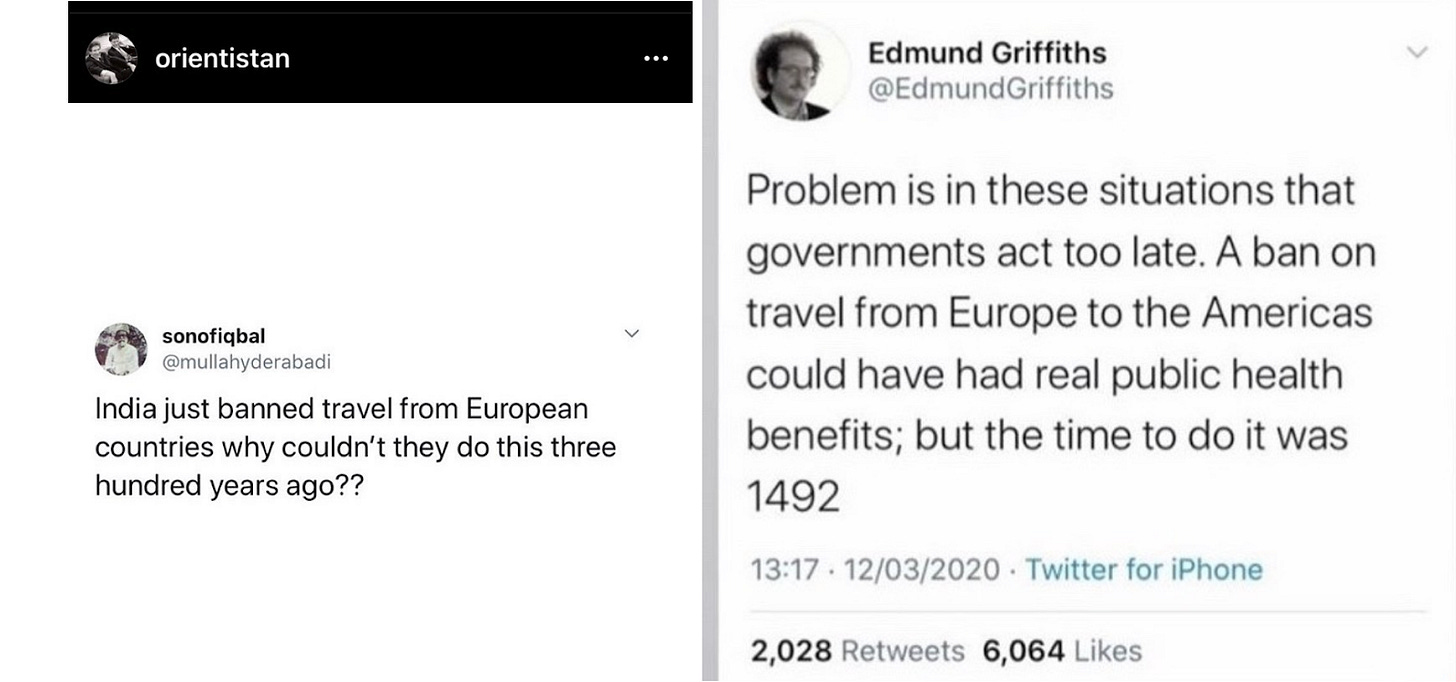
^The above, is, in a word: ACCURATE. These tweets not only comment on the violence of colonial incursions, but also the illogic of contemporary border closures, and the violent logic of borders in general. The tweet on the right was shared by my friend Parsa (@semipreciousmetal), who writes about borders, the legacy of the multiple partitions of Bengal, and much else!
Ephemera
Satisfying memes not only provoke a quick moment of recognition or laughter, but also elucidate something in a new light. They’re acts of writing and juxtaposition that are also acts of play (with a touch of defiance for good measure). The strange surprise of them? That’s art.
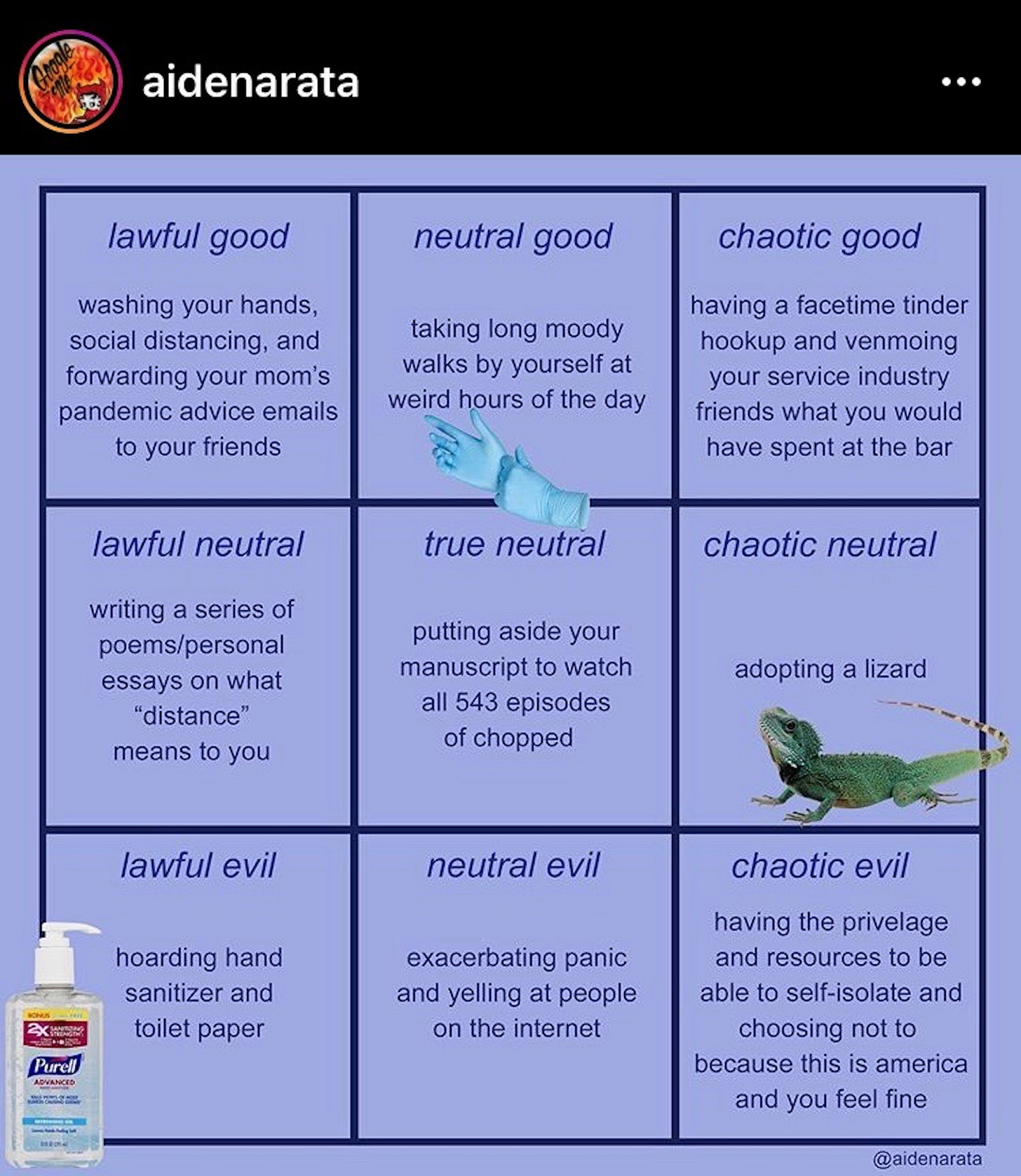
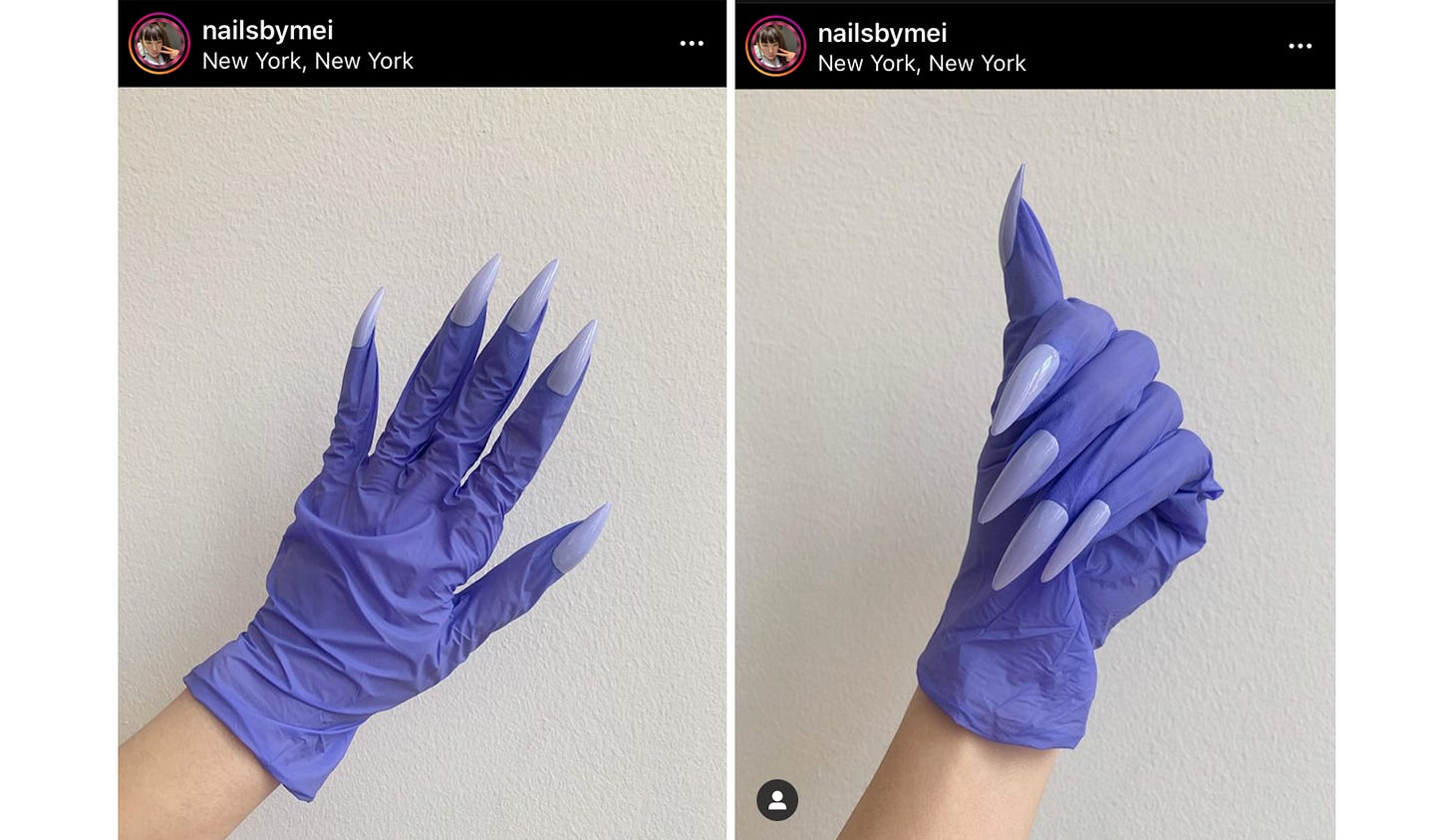
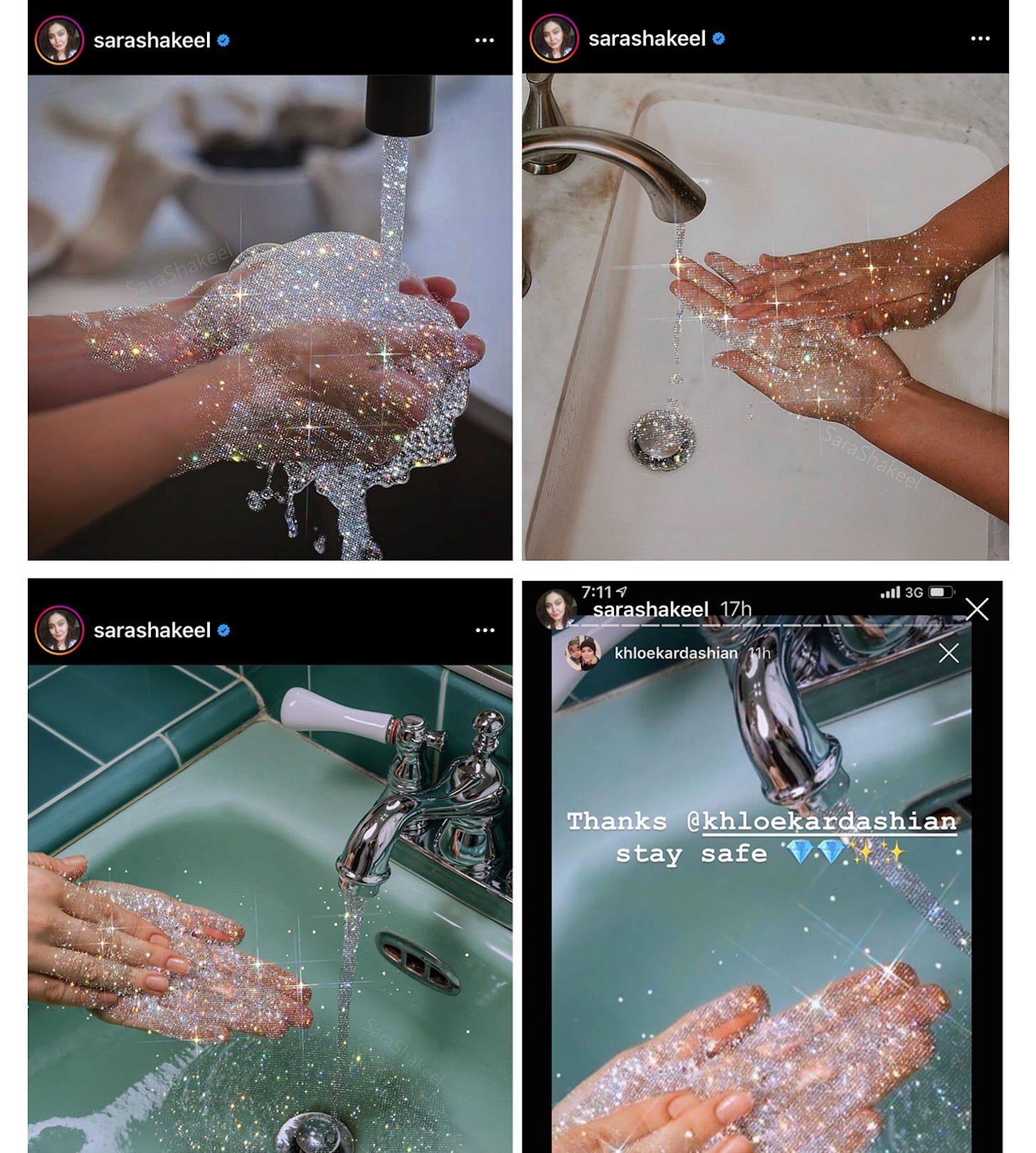
Stay strong and be well in these strange times!
— Grace and Dilshanie



